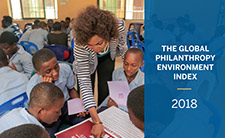Global Philanthropy Environment Index

The
latest report on the Global Philanthropy Environment Index has been released on
April 30, 2018.
latest report on the Global Philanthropy Environment Index has been released on
April 30, 2018.
Formerly
known as the Index of Philanthropic Freedom, this report evaluates
79 economies in 11 regions across five key factors that measure the ease with
which philanthropic organizations can operate, both within countries and across
borders.
known as the Index of Philanthropic Freedom, this report evaluates
79 economies in 11 regions across five key factors that measure the ease with
which philanthropic organizations can operate, both within countries and across
borders.
The
full report can be downloaded at:
full report can be downloaded at:
Currently only
regional reports are available on the website. However, all country reports
will become available on the website over the next couple of weeks.
India
is grouped under Southern and South-eastern Asia.
is grouped under Southern and South-eastern Asia.
The
‘Country Expert’ representing India for this study is the Centre for
Advancement of Philanthropy through its Chief Executive, Mr. Noshir H.
Dadrawala.
‘Country Expert’ representing India for this study is the Centre for
Advancement of Philanthropy through its Chief Executive, Mr. Noshir H.
Dadrawala.
To
read more, please go to:
read more, please go to:
The Region
The Southern
and Southeast Asian region includes South Asian countries: Nepal, India, and
Pakistan, as well as Southeast Asian countries: Myanmar, Vietnam, Thailand,
Indonesia, the Philippines, and Singapore.
and Southeast Asian region includes South Asian countries: Nepal, India, and
Pakistan, as well as Southeast Asian countries: Myanmar, Vietnam, Thailand,
Indonesia, the Philippines, and Singapore.
India,
Pakistan, and Nepal are members of the South Asian Association for Regional
Cooperation (SAARC) along with other South Asian nations.
Pakistan, and Nepal are members of the South Asian Association for Regional
Cooperation (SAARC) along with other South Asian nations.
Enabling conditions
The enabling
conditions for the philanthropic environment are at their best in Singapore and
the Philippines, and moderate in India, Indonesia, Pakistan, and Thailand,
whereas in the remaining regional economies, the situation is not encouraging.
The nearly ideal environment in Singapore is attested to by other sources, as
well.
conditions for the philanthropic environment are at their best in Singapore and
the Philippines, and moderate in India, Indonesia, Pakistan, and Thailand,
whereas in the remaining regional economies, the situation is not encouraging.
The nearly ideal environment in Singapore is attested to by other sources, as
well.
Economies
with a rather moderate enabling philanthropic environment are those that are
doing very well in some areas, but performing badly on many fronts. For
example, India, Pakistan, Indonesia, and Thailand have quite liberal policies
regarding the formation of organizations, but there are restrictions in certain
areas.
with a rather moderate enabling philanthropic environment are those that are
doing very well in some areas, but performing badly on many fronts. For
example, India, Pakistan, Indonesia, and Thailand have quite liberal policies
regarding the formation of organizations, but there are restrictions in certain
areas.
With regard
to tax exemptions, all four countries have more or less the same environment.
While India and Pakistan perform equally well in allowing tax benefits for
donors and receivers, Thailand’s tax policies for receiving charitable
donations are quite hampering.
to tax exemptions, all four countries have more or less the same environment.
While India and Pakistan perform equally well in allowing tax benefits for
donors and receivers, Thailand’s tax policies for receiving charitable
donations are quite hampering.
Indonesia
applies a completely different policy of tax benefit for donors from the rest
of the countries in the region. The tax law does not provide tax credits for
individuals, but corporate donors receive 100 percent of tax credits.
applies a completely different policy of tax benefit for donors from the rest
of the countries in the region. The tax law does not provide tax credits for
individuals, but corporate donors receive 100 percent of tax credits.
Sending
cross-border donations is one area that seems to be quite restrictive in many
of the economies. India not only links the outflow with approval of the Central
Board of Direct Taxes, but also conditions donations to match the interests of
India as a country. In Pakistan, though the process and policies are clear,
sending cross-border donations is a rarely observed practice due to resource
scarcity.
cross-border donations is one area that seems to be quite restrictive in many
of the economies. India not only links the outflow with approval of the Central
Board of Direct Taxes, but also conditions donations to match the interests of
India as a country. In Pakistan, though the process and policies are clear,
sending cross-border donations is a rarely observed practice due to resource
scarcity.
